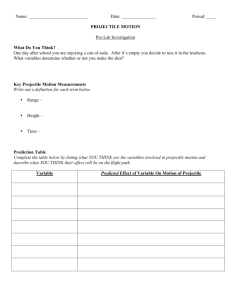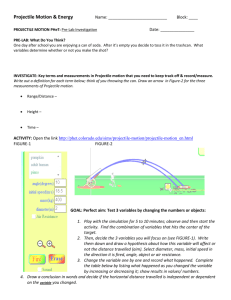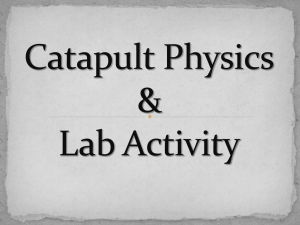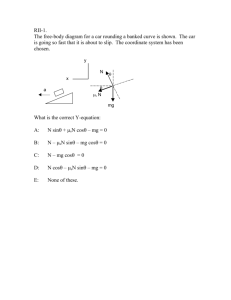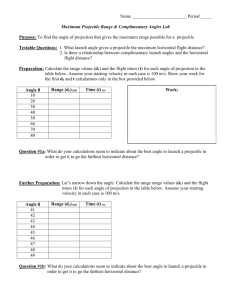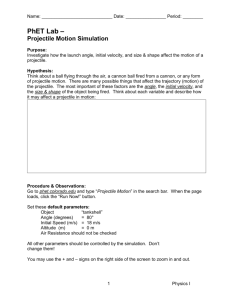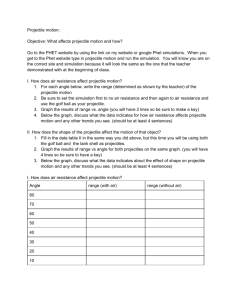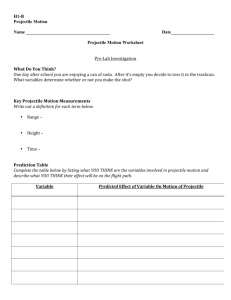Name - Hazlet.org
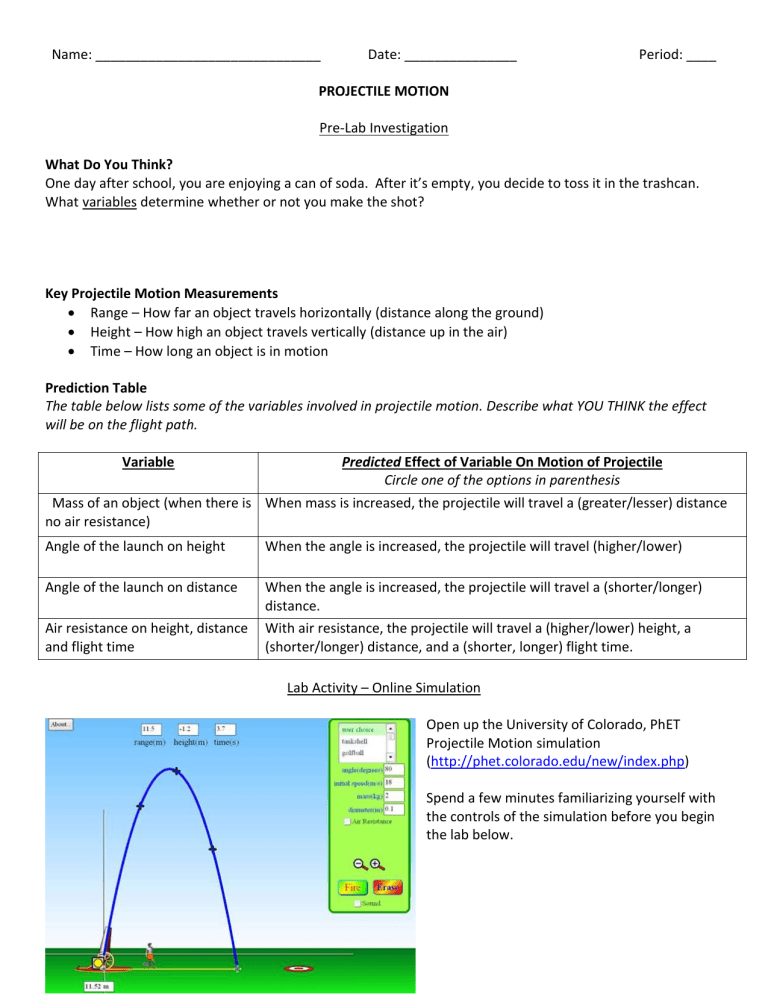
Name: ______________________________ Date: _______________ Period: ____
PROJECTILE MOTION
Pre-Lab Investigation
What Do You Think?
One day after school, you are enjoying a can of soda. After it’s empty, you decide to toss it in the trashcan.
What variables determine whether or not you make the shot?
Key Projectile Motion Measurements
Range – How far an object travels horizontally (distance along the ground)
Height – How high an object travels vertically (distance up in the air)
Time – How long an object is in motion
Prediction Table
The table below lists some of the variables involved in projectile motion. Describe what YOU THINK the effect will be on the flight path.
Variable Predicted Effect of Variable On Motion of Projectile
Circle one of the options in parenthesis
Mass of an object (when there is no air resistance)
When mass is increased, the projectile will travel a (greater/lesser) distance
Angle of the launch on height When the angle is increased, the projectile will travel (higher/lower)
Angle of the launch on distance When the angle is increased, the projectile will travel a (shorter/longer) distance.
Air resistance on height, distance and flight time
With air resistance, the projectile will travel a (higher/lower) height, a
(shorter/longer) distance, and a (shorter, longer) flight time.
Lab Activity – Online Simulation
Open up the University of Colorado, PhET
Projectile Motion simulation
( http://phet.colorado.edu/new/index.php
)
Spend a few minutes familiarizing yourself with the controls of the simulation before you begin the lab below.
Projectile Motion Data Sheet
Part 1: What is the effect of mass on the motion of a projectile? Air resistance is OFF
Angle
(degrees)
10
20
30
40
45
50
60
70
Object 1___________
Mass____________
Range Time
(meters) (seconds)
Object 2__________
Mass _______________
Range Time
(meters) (seconds)
80
90
1.
What do you notice about the flight time when the objects have different masses?
2.
What effect does mass have on your projectile?
3.
What does the path of the projectile look like at all angles except 90 degrees?
Part 2: What is the effect of the launch angle on the motion of a projectile?
4.
What happens to the range an object travels as you change the angle from 10 to 90 degrees?
5.
What happens to the height the object travels when you change the angle from 10 to 90 degrees.
6.
At what angle does the object travel the greatest distance?
7.
At what angle does the object have the greatest height?
8.
What angle give you the longest flight time of your object? Can you hypothesize why?
Part 3: What is the effect of air resistance on the motion of a projectile?
Fire the same objects that you launched in Part 1. Turn air resistance ON. Lines will be RED
Angle (degrees)
10
Object 1___________
Mass____________
Range (m) Time(s)
Object 2__________
Mass _______________
Range (m) Time(s)
20
30
40
45
50
60
70
80
90
9.
Air Resistance is also called _____________________.
10.
What else about an object affects air resistance? (Note that in this simulation the objects have different drag coefficients).
11.
Are the flight times longer or shorter when air resistance is on?
12.
Why do you think air resistance changes the flight times? Explain.
13.
What effect does mass have on the flight time of a projectile before air resistance is activated?
.
14.
If two objects with different masses were dropped on the moon, would they land at the same time? Why
15.
What is the over-all effect of air resistance on these characteristics of projectile motion:
(Answer with: increase, decrease or no effect.) a) Maximum Range: ____________b) Maximum Height: ____________c) Total Time _____________
Conclusion Questions:
Compare your predicted effects with your actual effects and answer the following questions.
1.
List and explain the predictions that you found to be incorrect after performing the tests. You can explain on an attached sheet of paper.
Variable Actual Effect of Variable On Motion of Projectile
Mass of an object (when there is no air resistance)
Angle of the launch on height
Angle of the launch on distance
Air resistance on height, distance and flight time
Challenge - Design a Test:
You’ve heard the claim that a bullet shot horizontally will strike the ground at the same time as a bullet dropped from the same height. Use the PhET simulation to test this theory.
1.
Describe IN DETAIL what you did to the variables on the simulation to test the theory: (HINT: you must have SOME initial speed to move the object out of the cannon).
2.
Record your findings (time of flight, distances, angles, etc):
3.
Did you prove or disprove the claim?


